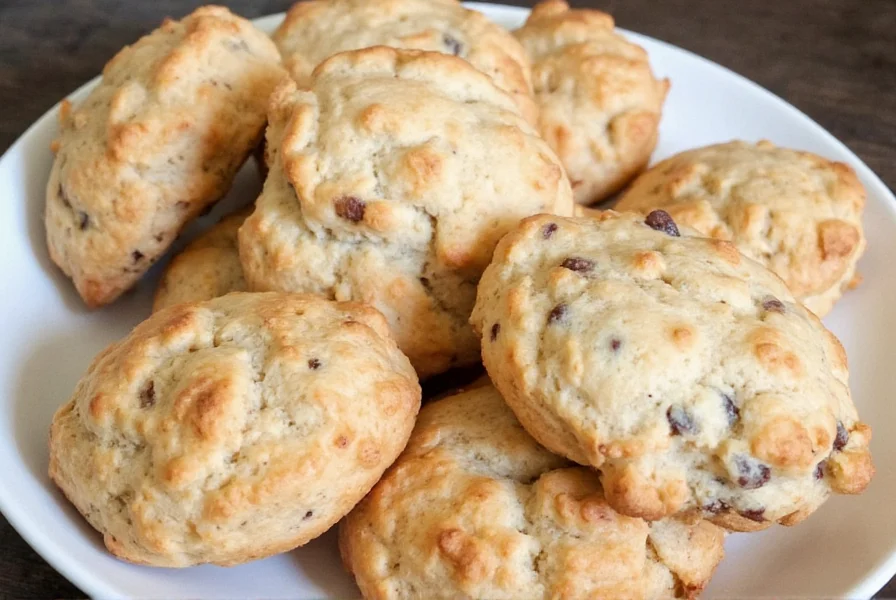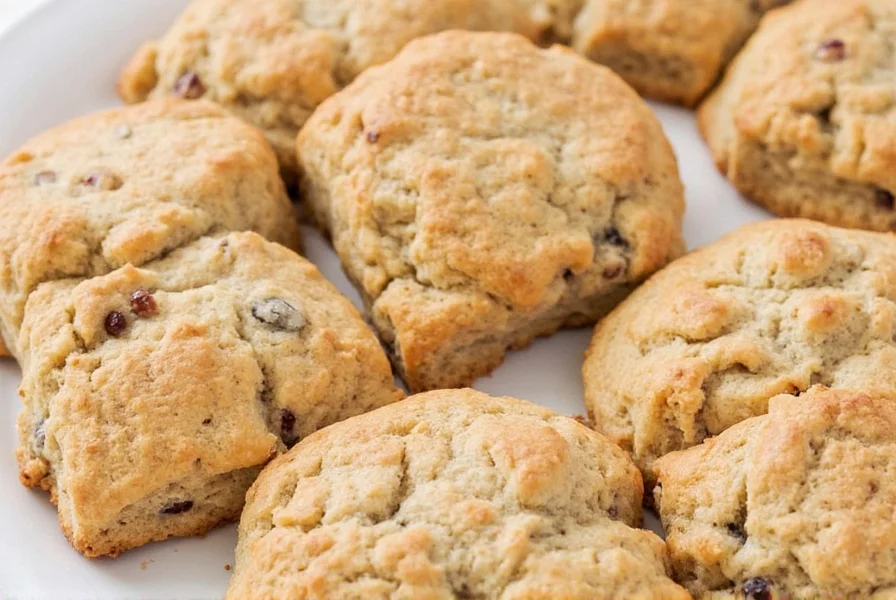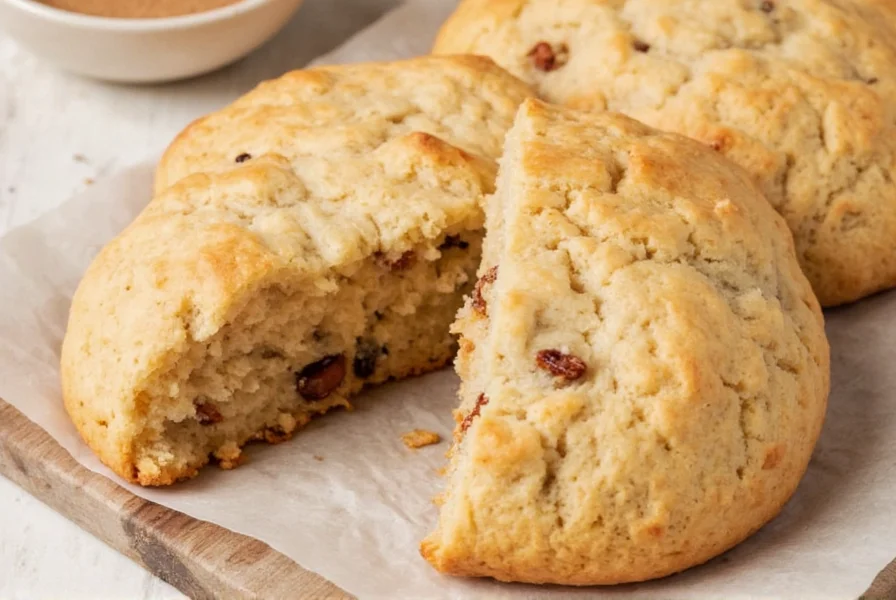Creating exceptional cinnamon raisin biscuits requires understanding the delicate balance between traditional biscuit technique and flavorful additions. Unlike regular biscuits, these sweet variations incorporate dried fruit and spices without compromising the signature flaky layers that define proper biscuit craftsmanship. The magic happens when cold fat creates steam pockets during baking, while the raisins plump perfectly without bleeding color or making the dough soggy.
The Science Behind Perfect Cinnamon Raisin Biscuits
Professional bakers know that successful cinnamon raisin biscuits depend on three critical factors: ingredient temperature, mixing technique, and baking precision. The fat (typically butter or shortening) must remain cold—below 60°F—to create the steam pockets that produce flaky layers. Room-temperature buttermilk would melt the fat prematurely, while ice-cold buttermilk could toughen the gluten. The ideal compromise? Buttermilk straight from the refrigerator (about 40°F).
Raisins present their own challenge. When added directly to dough, they can absorb moisture and create dense spots. The professional solution? Plump raisins in warm water or tea for exactly 10 minutes, then thoroughly pat dry before folding into the dough. This ensures they contribute moisture during baking rather than stealing it from the surrounding dough.
Essential Ingredients Breakdown
| Ingredient | Function | Professional Tip |
|---|---|---|
| All-purpose flour | Provides structure through gluten formation | Sift twice for even distribution and aeration |
| Cold unsalted butter | Creates flaky layers through steam pockets | Cut into 1/4" cubes and return to freezer for 5 minutes before use |
| Buttermilk | Activates baking powder, adds tang | Measure first, then chill while preparing other ingredients |
| Golden raisins | Sweet fruit pockets without excessive color bleed | Plump in Earl Grey tea for subtle floral notes |
| Cinnamon | Warms flavor profile | Mix 2/3 in dough, reserve 1/3 for topping |
Step-by-Step Preparation Guide
Follow this professional method for consistently excellent homemade cinnamon raisin biscuits recipe results. The entire process takes 35 minutes with 15 minutes of active preparation time.
- Prepare raisins: Soak 1 cup golden raisins in warm chamomile tea for 10 minutes. Drain and pat completely dry with paper towels
- Mix dry ingredients: Whisk 2¼ cups flour, 1 tbsp baking powder, 1/4 tsp baking soda, 1/2 tsp salt, and 1¼ tsp cinnamon in a large bowl
- Cut in butter: Work 1/2 cup frozen butter cubes into flour mixture using a pastry cutter until pea-sized crumbs form
- Add liquid: Make a well, pour in 1 cup chilled buttermilk, and gently fold with a spatula until just combined
- Fold in raisins: Add dried raisins and remaining 1/4 tsp cinnamon, folding 8-10 times to distribute evenly
- Shape dough: Turn onto floured surface, gently pat to 3/4" thickness, and cut with 2½" biscuit cutter
- Bake: Place on parchment-lined sheet 2" apart, bake at 425°F for 12-14 minutes until golden brown
Avoiding Common Cinnamon Raisin Biscuits Mistakes
Even experienced bakers encounter issues with this variation. Understanding these pitfalls ensures perfect results every time:
- Soggy bottoms: Caused by excess moisture from improperly dried raisins. Always pat plumped raisins thoroughly dry
- Dense texture: Results from overmixing or warm ingredients. Handle dough minimally and keep everything cold
- Uneven cinnamon distribution: Mix most cinnamon into dry ingredients but reserve some for topping for balanced flavor
- Flat biscuits: Oven temperature too low or expired leavening agents. Test baking powder freshness monthly
Variations for Different Preferences
Customize your cinnamon raisin biscuits recipe while maintaining structural integrity:
- Gluten-free version: Substitute 1:1 gluten-free flour blend and add 1 tsp xanthan gum
- Vegan adaptation: Use coconut oil instead of butter and almond milk with 1 tbsp vinegar for “vegan buttermilk”
- Spice variations: Add 1/4 tsp cardamom or nutmeg to complement cinnamon without overpowering
- Texture enhancement: Sprinkle coarse sugar on top before baking for subtle crunch
Serving and Storage Recommendations
Cinnamon raisin biscuits shine when served warm but maintain quality through proper storage. For best results with your homemade cinnamon raisin biscuits recipe:
- Immediate serving: Brush tops with melted butter and sprinkle with cinnamon sugar while still warm
- Pairing suggestions: Excellent with clotted cream, sharp cheddar, or alongside savory breakfast meats
- Short-term storage: Keep in airtight container at room temperature for up to 2 days
- Long-term preservation: Freeze unbaked cut biscuits on tray, then transfer to freezer bag. Bake from frozen, adding 2-3 minutes to baking time

Why Cinnamon Raisin Biscuits Outperform Regular Biscuits for Breakfast
While traditional buttermilk biscuits serve as perfect savory accompaniments, cinnamon raisin variations offer distinct advantages for morning meals. The natural sweetness from plump raisins eliminates need for additional syrup or jam, creating a more balanced breakfast option. The cinnamon content provides subtle warmth that complements coffee or tea better than plain biscuits. Most importantly, the fruit inclusion adds dietary fiber and natural sugars that provide sustained energy release compared to simple carbohydrate-heavy regular biscuits.

Perfecting Your Technique Through Practice
Mastering cinnamon raisin biscuits requires attention to detail but yields impressive results. Track these metrics during your baking attempts to refine your perfect cinnamon raisin biscuits from scratch method:
- Measure ingredient temperatures with a kitchen thermometer
- Count your folds during mixing to maintain consistency
- Record oven temperature with an independent oven thermometer
- Note baking time variations at different altitudes
Within three attempts, most home bakers achieve professional-quality results by adjusting just one or two variables in their process. The ideal biscuit should reach 1¼" height with visible flaky layers and a golden brown exterior that gives slightly when pressed.
Frequently Asked Questions
Can I use regular raisins instead of golden raisins in cinnamon raisin biscuits?
Yes, but golden raisins are preferred for cinnamon raisin biscuits because they're plumper, sweeter, and less likely to bleed color into the dough. If using regular raisins, reduce soaking time to 7 minutes to prevent excessive darkening of the biscuit interior.
Why do my cinnamon raisin biscuits come out dry?
Dry biscuits typically result from overbaking, too much flour, or insufficient fat. Measure flour by spooning into measuring cups (don't scoop), ensure butter remains cold, and remove biscuits from oven when internal temperature reaches 200°F. The dough should look slightly underdone when removed as carryover cooking will finish the process.
How can I prevent raisins from sinking to the bottom of my biscuits?
Properly plumped and dried raisins distribute evenly when folded into the dough. Toss dried raisins with 1 tablespoon of the measured flour before adding to the mixture. This light coating helps them suspend throughout the dough rather than sinking during baking.
Can I make cinnamon raisin biscuits ahead of time?
Yes, prepare the unbaked biscuits up to 24 hours in advance. Place cut biscuits on a parchment-lined baking sheet, cover tightly, and refrigerate. Bake directly from cold, adding 2-3 minutes to the baking time. For longer storage, freeze unbaked biscuits on a tray, then transfer to freezer bags for up to 3 months.











 浙公网安备
33010002000092号
浙公网安备
33010002000092号 浙B2-20120091-4
浙B2-20120091-4